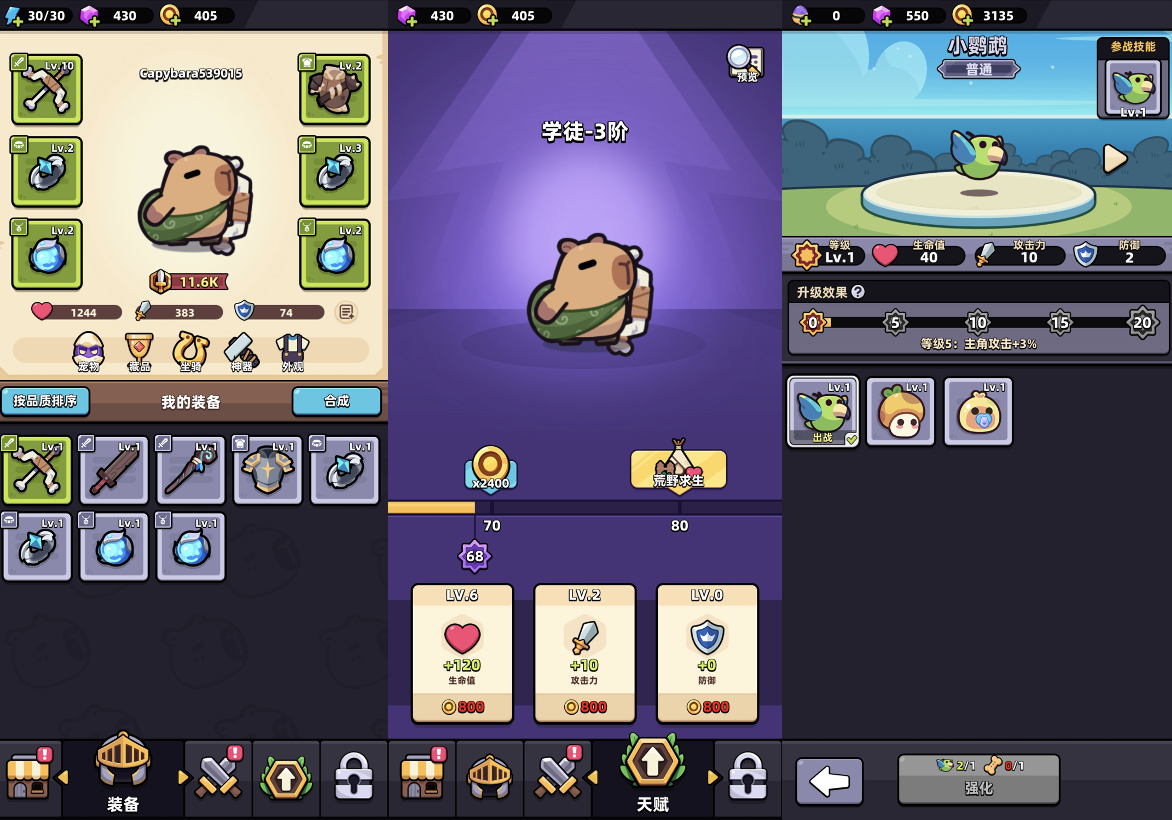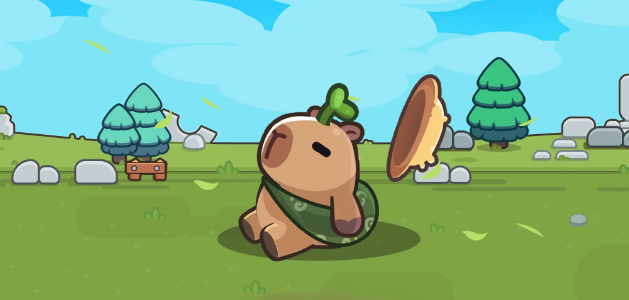In September, a mobile game called Capybara Go! has been launched in a few markets and has achieved good results in some Southeast Asian markets, successfully breaking into the Top Grossing iOS Games 10 in both Vietnam and Singapore.
Since its exposure, Capybara Go! has attracted significant attention in the industry, not only for the product's own performance but also because of the manufacturer behind it, Habby, which has launched several hit casual games.
By the way, the R&D studio behind Capybara Go! is Gorilla Games, the same team that brought us Archero and Survivor!.io.
Archero helped Habby establish its reputation in the industry after only a year of existence, while Survivor!.io once again refreshed the industry's perception of Habby with a monthly revenue of 300 million, with a combined estimated revenue of both games exceeding 8.5 billion.
Naturally, Capybara Go!, also from Gorilla Games, is expected to live up to high expectations.
Now, the game has started well in Southeast Asia, and AppGrowing has detected that the game is expected to launch in Hong Kong, Macao, Taiwan, and Japan and South Korea regions later this month.
After testing and validation in regions such as Vietnam and Singapore, Habby has increased its investment in the Hong Kong, Macao, Taiwan, and Japan and South Korea regions, beginning preparations for the launch.
It will certainly be interesting to see what Capybara Go! will come up with then.However, before that , let's take a step ahead and see what kind of game Capybara Go! is, and what actions Habby has taken in promotion?
01.A product of the “successful product formula”
This time, Habby has chosen to dress the game in the guise of traffic.
In Capybara Go!, the character that players control is a capybara, which also has a more well-known name on the Chinese internet—"Capibara", The homophonic translation of "capybara" in Chinese.
Due to its stable emotions and extreme relaxation, capybara has become an outlet for young people who are "too tired to strive, too restless to lie flat" to heal themselves and escape reality.
Coupled with the promotion of various abstract and frenzied literature on the Chinese internet, capybara has become a top internet celebrity for a time.
However, beneath the popular exterior of capybara lies a somewhat retro MUD gameplay.
Once players enter a level, the screen is divided into two parts, with the upper part displaying capybara's actions visually, but the more important content is actually the textual description below.
Every time players press the "Next Day" button at the bottom of the screen, they advance to the next level and trigger various random events.
These events bring various positive and negative effects to the character, and when enemies are encountered, battles are triggered.
In this process, Habby has incorporated their expertise in the "rouge-like" elements.
Whenever corresponding events are triggered or the character levels up, players can choose one skill card from three options, thereby enriching the in-game skill build and enhancing the strategic depth of the game.
As the game progresses, additional gameplay features such as tower climbing, arenas, and material dungeon challenges will be unlocked.
In terms of character development, similar to Habby's previous games, Capybara Go! also features a comprehensive character progression system that includes equipment, talents, pets, and more.
Worth mentioning is the treasure chest system unlocked after completing Chapter 3. Players can obtain chests of different tiers by completing specific tasks, challenging dungeons, and embarking on journeys.
Opening chests of different tiers also grants different points, and when the points reach a certain threshold, players can receive free chest rewards. It's not hard to see that this is essentially the popular "loot box" mechanic found in many casual games today.
Treasure chests can contain a variety of resources for character development, and collectibles are among the more critical rewards, also constituting a significant character progression system within the game.
Collectibles not only serve to enrich the collection but also provide tangible boosts to the player's combat power.
Overall, Capybara Go! remains a very "Habby" game. Looking back at most of Habby's past products, they are essentially simple to operate and provide direct feedback in casual gameplay.
This time, Capybara Go! does not require any player operation.As long as you press the button, you can get immediate feedback.
However, behind the seemingly casual gameplay design lies a complete set of mid/hard-core progression system.
The existence of these systems makes deep monetization design possible, which also allowed Habby to become one of the earlier teams to successfully implement the "IAP+IAA" hybrid monetization model. This time, Capybara Go! also adopts a hybrid monetization design.
Over the years, under the guidance of the philosophy of "light gameplay + mid/hard-core progression," Habby has explored a "successful product formula" that is uniquely their own, which is "an addictive casual gameplay + roguelike elements + peripheral progression." Capybara Go! is undoubtedly a product born within this framework.
That being said, the performance of Habby's products cannot be summarized by such a simple formula.
According to Sien Wang, when creating new products, they always consider innovative gameplay for a single session and do not focus solely on game monetization; they conduct more than 20 gameplay tests each year, and the development cycle for each product is no less than half a year, with some even exceeding a year.
As a company that builds products around producers and deeply participates in the production process, Habby's moves on the publishing side are equally significant.
02.Is there a "successful formula" for distribution ?
Looking at Habby's previous products, they generally engage in large-scale Ads activities, but the pace of these products' launch and promotion is often inconsistent.
According to Sien Wang, during the initial launch of their products, they are essentially conducting a large-scale test.Only when the data across all dimensions, such as monetization and retention, meet the standards, will they begin large-scale promotion.
The deployment of Capybara Go! follows this approach as well. Data monitored by AppGrowing shows that after the game was launched in some regional markets at the end of August, although Habby followed up with deployment immediately, the number of deployments in the following month remained at a relatively low level.
It was not until the end of September that Capybara Go! showed a significant upward trend.
At this point, the game had already achieved relatively impressive results in places like Vietnam and Singapore, indicating that various data had been well-validated, and it was ready to be promoted to more markets, so the Ads efforts began to intensify.
In addition to the staggered launch and promotion pace, Habby's regional distribution strategy is also worth paying attention to.
As early as the release of PunBall, Habby had already begun to adopt a regional distribution strategy, replacing the previous global promotion approach.
According to their global team, their general direction is "East first, then West," and the distribution trajectory of Capybara Go! also confirmed this point.
In the past, Sien Wang mentioned that simple and understandable gameplay is one of their Ads advantages, and the logic is somewhat similar to the popular minigame Ads of nowadays.
This also leads them to pay great attention to showcasing the gameplay in their advertisements, and Capybara Go! also has a lot of creatives related to gameplay.
However, perhaps because the MUD operation is too simple, Habby played a "psychological warfare" with users in creatives creation, deliberately showing scenes of characters continuously defeated, trying to stimulate players' desire to challenge in this way.
 Source: AppGrowing
Source: AppGrowing
In addition to gameplay, thanks to regional distribution, they have also adopted a more refined localization strategy for Ads.
For instance, in the South Korean market, Capybara Go! invited 안재홍 to endorse the game. He is well-known for his roles in works such as Reply 1988 and remains active in the South Korean film industry today.
Capybara Go! has released numerous advertising creatives featuring 안재홍, who seriously explains the game's gameplay features and high welfare content.
 Source: AppGrowing
Source: AppGrowing
However, in markets such as Hong Kong, Macao, Taiwan and Japan, the art styles of the promotional creatives obviously use more elements like beautiful women appearing on the screen and popular trends on TikTok. These contents are more in line with the preferences of users in Hong Kong, Macao, Taiwan and Japan.
For example, in the following one, the brainwashing "Capybara" music is paired with beautiful women dancing passionately. Coupled with various cute characters in the game flashing in the background, the video is both dynamic and captivating. This kind of slightly wacky content also better suits the preferences of users in the aforementioned regions.
 Source: AppGrowing
Source: AppGrowing
03.How will Habby develop next?
When Habby first gained the industry's spotlight with Archero, many people considered them a casual or even hyper-casual game developer.
However, in Sien Wang's view, no hyper-casual game would take a year of development time. In their plan, Archero was meant to be a mid-core game.
Subsequently, Habby has been on the track of mid-core casual games and has achieved considerable success.
But in recent years, as competition in the gaming market has further intensified, hard-core games have begun to expand into the casual sector by leveraging mini-games to compete for traffic. And hyper-casual games have shown a trend towards becoming more mid/hard-core, focusing on long-term operation.
For Habby, these undoubtedly intensify the competitive pressure in the track they are in. While Habby's product strategy has been the foundation for their consistent production of hits, it has also limited them in turn.
Faced with the evolving market situation, Habby is actively exploring its possibilities. Last year, they launched a game like SOULS, which was somewhat "unusual." This game has a unique temperament, but its gameplay design is somewhat traditional, distinctly different from Habby's previous lineup of games.
On the other hand, Habby is also exploring the possibility of IP development. In fact, in addition to Capybara Go!, Habby has another game that has been launched in a few regions at the same time.
Although it is still in the debugging phase, this product bearing the title Archero 2 has already begun to attract industry attention. As for whether the path of IP development can be successful, it is obviously not yet known.
Facing the ever-changing market environment, how long can Habby continue on the mid-core casual track? In the future, how will they expand their possibilities? These questions are certainly worth our continued attention in the future.









